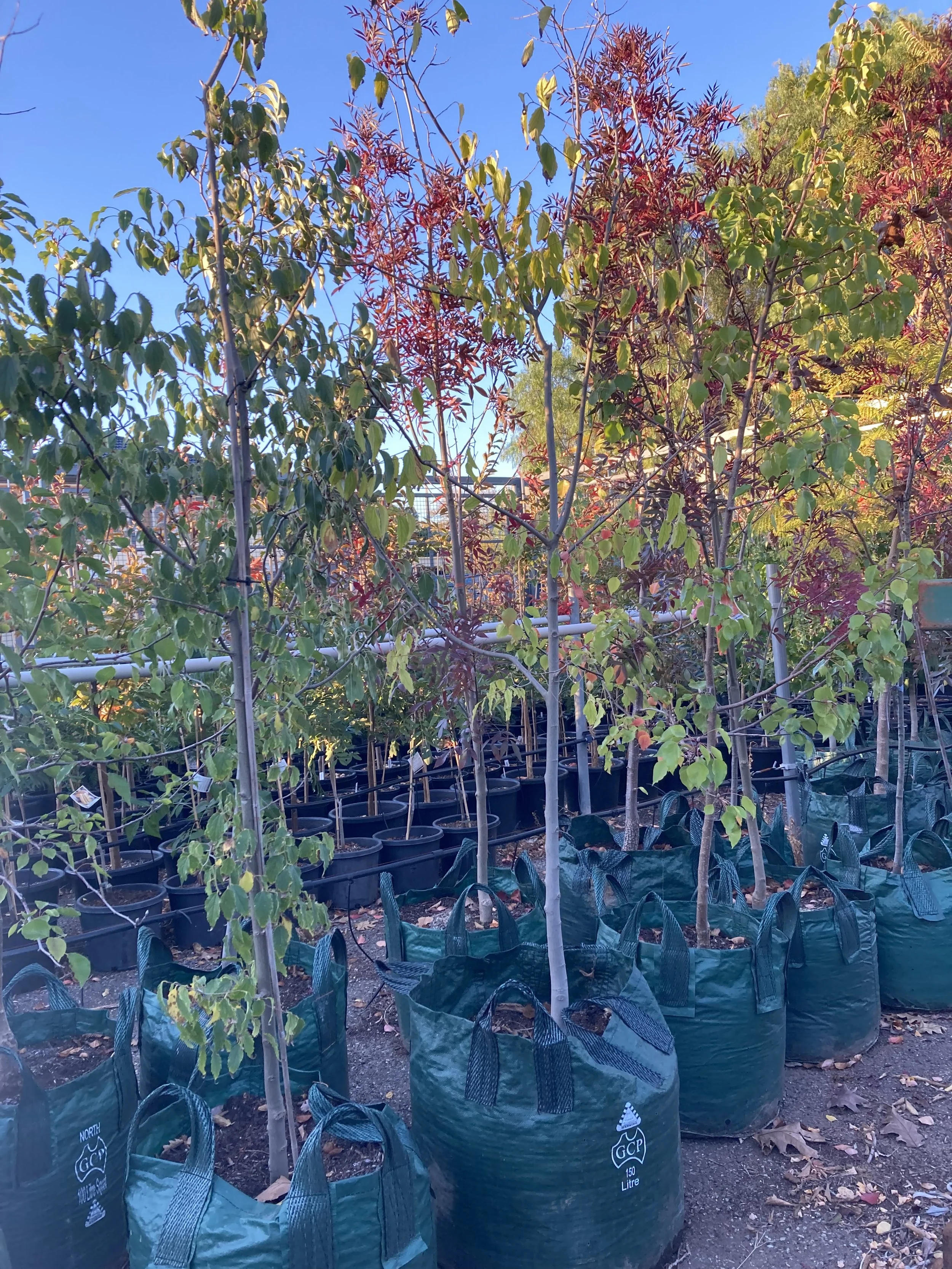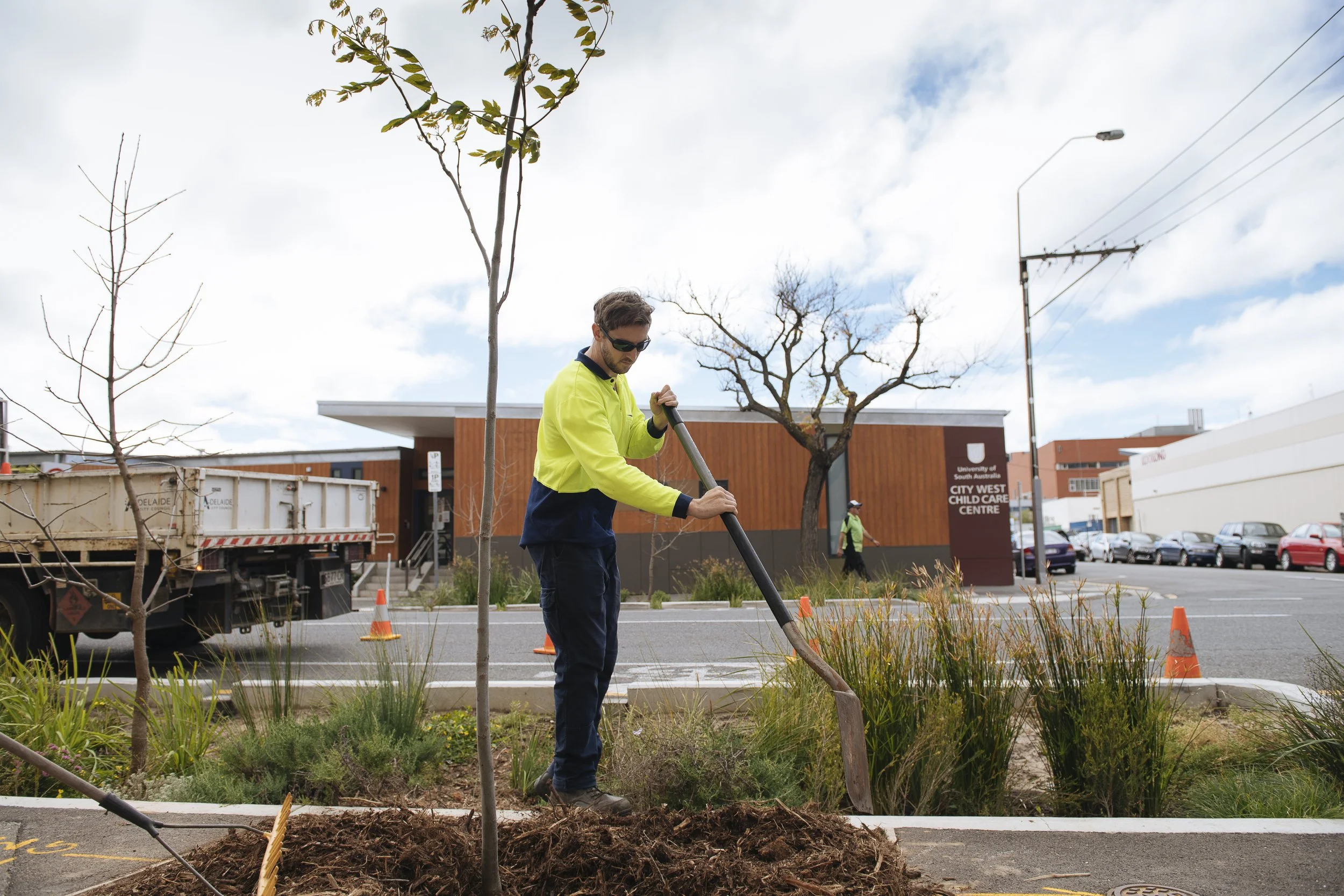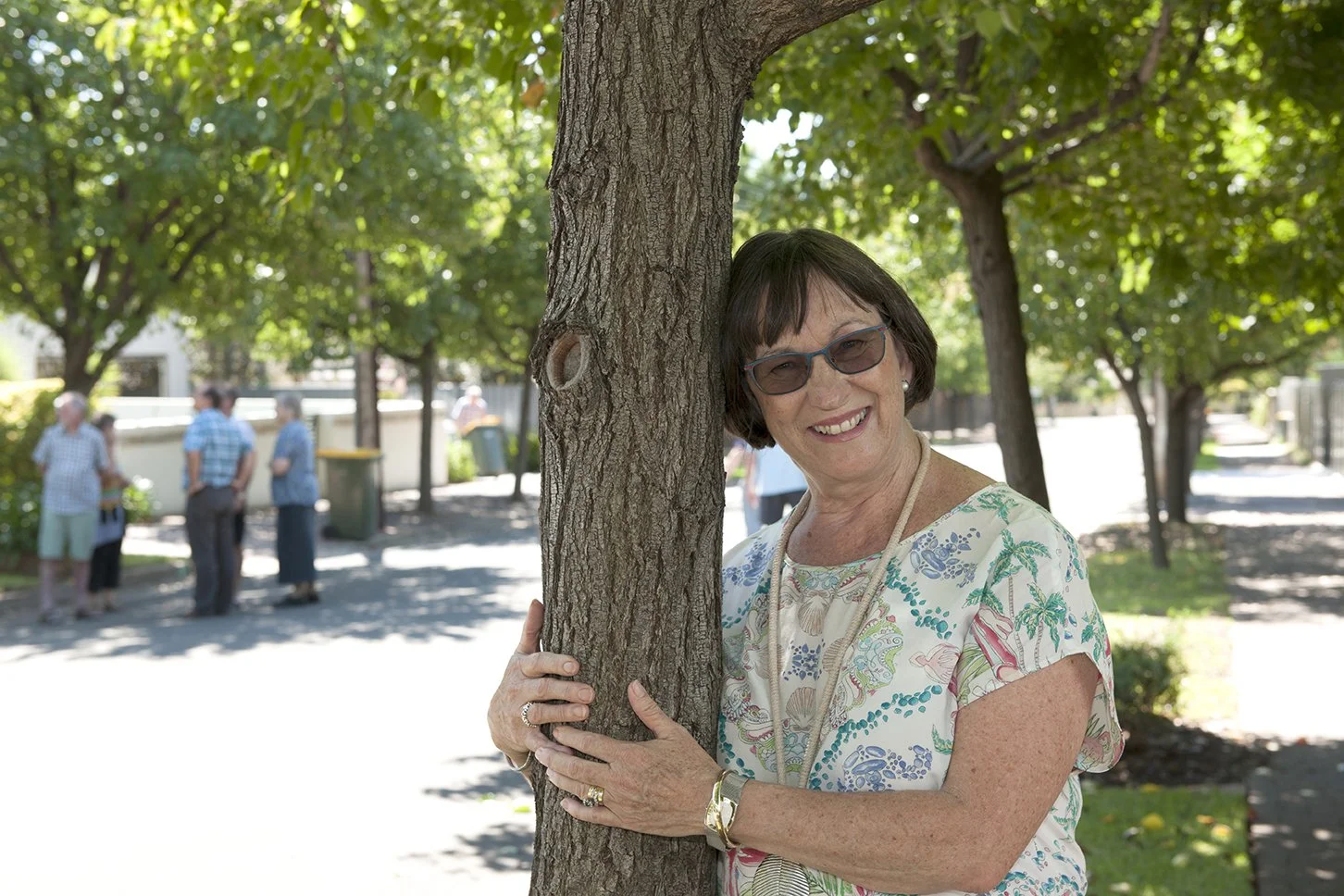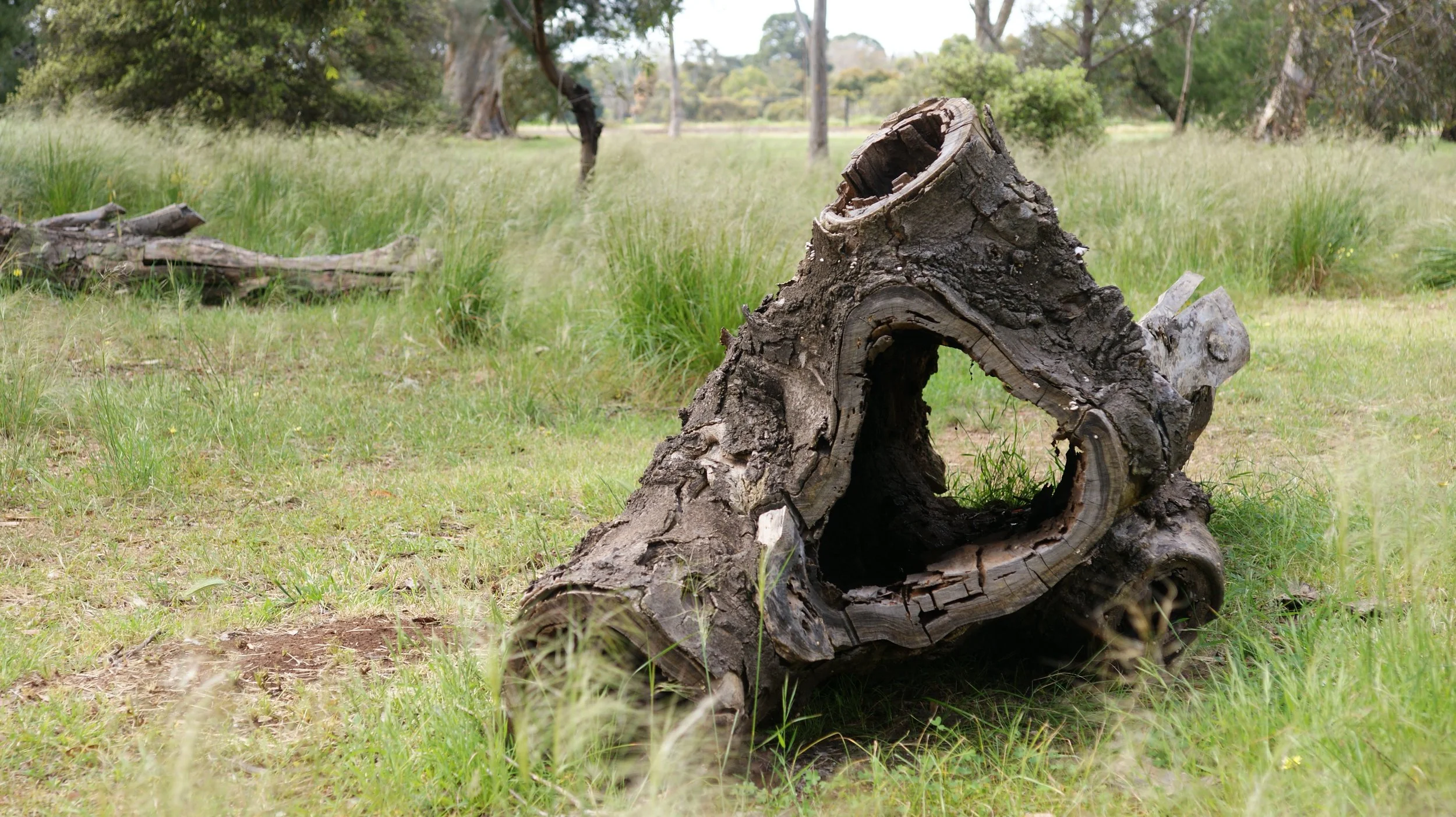Trees play a vital role in our community and they provide us with many benefits.
We often encounter common beliefs and challenges, and are asked similar questions from our community relating to trees and their management.
So, we’ve come up with 21 FAQs and answers to help your curiosity! The questions are grouped under three themes (New trees, Living with trees and Tree removal) to help you find what you’re looking for.
Ten of the FAQs feature a complementing ‘You Can’t Arb That!’ video - 90 second engaging interviews with arborists from Resilient East and Resilient South councils. These tree experts answer questions and explain misconceptions they often encounter.
Of course, if you have any further questions please branch out to us, or your local council.
New Trees
-
Trees play a vital role in our community and they provide us with many benefits.
Not only do they enhance the beauty of our neighbourhoods and create a sense of place, they also improve air quality, reduce wind, provide habitat for wildlife, cool our homes during heatwaves, increase property value, hold cultural and historical value, reduce local flooding, improve our mental health, and much more!
All of these benefits help to create a great place to live, so that’s why we are committed to caring for our trees, while planting new ones to ensure future generations benefit too.
Our partner councils care for hundreds of thousands of trees across eastern Adelaide, and have strategies and targets in place to ensure a desired level of green cover is reached.
These targets align with State Government targets to increase urban green cover by 20% by 2045 as part of the 30-Year Greater Adelaide Regional Plan.
You can enjoy the many benefits trees provide right in your own garden!
Can you plant a new tree, introduce a potted one, or increase overall greenery on your property?
-
Trees are long-lived assets that provide benefits over many generations, therefore we carefully plan and select trees to ensure they thrive and survive over many years, so our community gets the best out of them.
Our partner councils have strategies that set priorities for planting and maintaining trees within our region. Councils plant a mixture of local native, exotic, evergreen and deciduous species to ensure diversity and the character of our suburbs is maintained.
Street tree planting is also governed by legislation, including the Local Government Act 1999, Electricity Act 1996, Electricity (Principles of Vegetation Clearance) Regulations 2010 and the Water Industry Regulations 2012.
New trees are selected by qualified arborists who consider a number of factors, like;
• availability and quality of the tree species/type;
• location and planting conditions;
• space available (above and below ground);
• soil type;
• water availability;
• maintenance requirements;
• surrounding habitat and wildlife;
• nearby infrastructure like powerlines, stormwater pipes etc. (above and below ground);
• proximity to buildings;
• visibility and safety (i.e. unobscured road signs)
• sensitivity to disease and pests;
• local culture, heritage and sense of place; and
• resilience to climate change.
Plantings are prioritised in suburbs with low canopy cover, areas with higher populations of vulnerable people, or areas that are more impacted during heatwaves.
When our partner councils plan for new street trees, they engage with nearby residents or businesses to collect their feedback and views. When possible, they are offered a choice of trees to select from.
If there’s space for a tree in front of your property, contact your local council to request one. If you have a particular tree species in mind, include this so they can consider your preference.
Please note, planting a tree may not be possible in your location for reasons like limited space or interference with underground infrastructure.
-
Avenue planting (where both sides of a street is lined with the same tree species) has been a popular practice to achieve a uniform look.
This approach is becoming less preferred as it creates a higher risk of street-wide tree loss if there is pest infestation, disease, drought or heatwaves. This is because different tree species (and ages) have different tolerances. Where one tree can survive a drought, another may die. Similarly, pest and disease may impact one type of tree, and not another.
An example of this can be seen in 2023, where hundreds of pine trees had to be removed in Highbury due to an outbreak of giant pine scale.
It’s best to plant a mixture of different trees and ages, so when one of these threats comes along, less trees are impacted.
By planting different species and ages, we also avoid all the trees reaching the end of their lives at the same time.
This diversity promotes long-term tree health, increases local biodiversity, provides better habitat for wildlife, and improves resilience to climate change – not only for trees, but for people and property too!
When we select trees to plant, we also look at their sensitivity to threats to make sure we have trees that can be enjoyed for many years.
Of course, some avenue plantings have significant or historical value in our region, and it is important that we recognise and preserve these.
Living with trees
-
As part of our commitment to protecting trees and ensuring they stay healthy and safe, our partner councils have proactive tree management and maintenance programs .
Council arborists undertake regular health assessments and risk audits for each tree every one to five years. This timeframe varies from tree to tree as it depends on type, location, age and other factors. Trees of higher risks or in frequently used areas (like parks and playgrounds) are assessed more often.
These assessments help to map out pruning programs, and other requirements a tree may need, like pest treatment or watering.
There are many reasons why we prune trees. Pruning helps maintain structural stability and extends life expectancy, as well as reduces risks from branch failure. We also prune to clear access for roads and paths.
Our aim is to allow trees to develop a natural shape and prune only what is needed, so the tree is not negatively impacted.
Young trees receive extra care and pruning until they are established to grow strong and form a suitable shape.
We also prune trees outside of our regular pruning program if they are damaged during storms or by vehicles.
South Australian Power Networks inspects and prunes trees under powerlines regularly to make sure that power infrastructure is safe and reliable. More information is available on their website.
Members of the public are not permitted to prune, alter or damage any trees on public land. Any suspicious activity can be reported to council.
Trees will not be pruned or removed by councils to reduce fruit, leaf and other debris fall, remove birds or other wildlife, improve views, reduce shading of lawns or gardens, improve visibility of property signage or increase street lighting on private property.
-
If a council tree is overhanging your property, you can request a pruning assessment.
Each request is inspected by a qualified arborist who follows the Australian Standard for tree pruning.
The assessment will consider a number of factors, like how pruning will impact the health and structural stability of the tree. Proximity to infrastructure and buildings and risk to the community will also be considered.
Generally speaking, a tree overhanging a property does not warrant pruning.
If an arborist decides pruning is required, then only the minimum amount required will be trimmed. For example, a branch may be pruned, but it won’t necessarily be pruned to the property boundary line.
-
South Australian Power Networks (SAPN) is required by legislation to regularly inspect and clear trees around power lines. This ensures we have safe and reliable access to electricity, reduces the risk of downed power lines, outages and bushfires.
This work is completed by SAPN and their contractors. You can find out more about SAPN tree trimming on their website.
-
If pipes are in good condition, tree roots are ‘unaware’ they contain any water inside, and therefore, will not be attracted there or cause any harm to the pipe.
Tree roots typically only intrude on already damaged or leaking pipes as they seek water and nutrients they need to grow. Once a damaged pipe is repaired, the issue of root intrusion is no longer present.
If you have any concerns about your property, consult with a professional plumber who can remove roots and repair the pipes.
If the tree is a Significant or Regulated Tree, you must follow the required legislation which can be found on your councils website.
Similarly, damage to structures like buildings, walls, drains and paving is rarely due to root activity alone. Seasonal soil moisture changes, soil type (such as Adelaide’s highly reactive clay soils) and poor building foundations are common contributors to damaged structures.
If you have a concern relating to a tree on public land (i.e. roads, streets, parks), please contact the local council.
-
Trees on private land:
Property owners are responsible for removal, repairs and insurance claims relating to trees on their land.
If you require emergency assistance for a tree or branch that has fallen during a storm on your property, please contact the State Emergency Services (SES) on 132 500.
Tree on public land:
If a council tree or branch is causing a dangerous situation, please call the local council immediately.
For non-urgent issues, you can submit a request via councils website.
Trees and power lines:
If a tree or branch has fallen and is impacting powerlines or related infrastructure, please call SAPN immediately on 13 13 66.
-
Keeping our streets and roads clean and safe is a high priority for our community.
Our partner councils have a regular street sweeping and cleaning program that is undertaken throughout the year. There are also certain times when this frequency is increased, like during autumn or on streets where trees shed more litter.
Council street sweeping programs improve road and footpath safety and reduce excess leaf litter and other materials from entering the stormwater system.
We know trees require maintenance, but the benefits they provide are tree-mendous and worth the effort!
While we make every effort to keep our streets clean, we appreciate the efforts of our residents and community members.
You can help out by:
• collecting tree litter and placing it in your home compost, garden bed or green organics bin;
• not sweeping leaves or clippings onto the road or into piles (our street sweepers have trouble with piles of leaves); and
• not parking cars, caravans, trailers or boats on the road for extended periods where litter can build up underneath.
If you notice an area that requires attention, please contact council.
-
Modern solar panels have improved technology to allow them to perform in some shaded conditions, compared to older models.
Reputable installers are trained to install panels in locations that maximise sunlight and minimise shade, so make sure your local conditions are carefully planned for before installation.
Councils will not prune or remove trees that shade existing or proposed solar panels.
If the tree is owned by your neighbour, you can have a chat to them. More information can be found in this guide, Trees and the law.
If the tree is a Significant or Regulated Tree, you must follow the required legislation. More information can be found on your councils website.
It is important to note that trees provide many cooling benefits to our homes as they not only shade areas from the sun, but they also act like air conditioners, by cooling local air through moisture evaporating from their leaves. This in turn reduces the cost and energy required to cool homes and run air-conditioners.
-
Councils regularly inspect footpaths, streets and roads to ensure they are well maintained and safe.
If a council tree is causing a hazard, like roots lifting pavers or a low hanging branch in a walkway, they will take steps to rectify the issue.
A slip/trip hazard can be caused by leaves, berries and other tree litter falling on a footpath or bikeway. This litter is part of the natural cycle of trees. These areas are swept regularly, and extra attention is given to areas of high litter fall, main roads and during seasonal changes.
If you have noticed a hazard, please report it to council.
We love taking care of our trees, and we always appreciate when our community helps out. You can assist by sweeping the footpath near your home. You can use the tree litter in your garden as mulch, or add it to home compost or simply place it in your green organics bin for collection.
-
Trees provide many benefits to our urban environments, including food and shelter for local wildlife.
If you enjoy seeing wildlife, you can enhance your experience by planting a diverse variety of plants and trees on your property. Consider using native species known to attract local birds, butterflies and other wildlife. You can also install bird feeders, bee hotels, bird baths, nesting boxes and put clean water in shallow bowls on your property, especially in hot weather.
Trees provide habitat to birds, insects and critters we can’t even see, so if you’re lucky enough to have a tree on your yard, ensure it is well maintained and kept for current and future generations to enjoy.
While some people adore wildlife watching and hearing bird songs, we understand that at times these can become a nuisance. If you’re concerned about trees on your property attracting wildlife, you can keep fruit trees netted, add deterrents like reflective objects or imitation owls, and ensure there are no access points or gaps in your home or roof that may allow pests to enter.
Generally speaking, wildlife nuisances come and go with seasonal changes, and are unlikely to remain year round.
We value our diverse urban environments and our partner councils will not remove a tree due to nuisances.
-
Gutter cleaning and maintenance are the responsibility of property owners to ensure homes and buildings remain safe and undamaged.
Our partner councils are providers of the Commonwealth Home Support Programme (CHSP) which offers support to eligible members of the community.
This includes discounted services to help with home maintenance, including gutter cleaning.
You can find out more on your council website.
If a council tree is overhanging your home or building, you can put a request in to have it pruned. For more information, please see Question 5 (above): ‘A council tree is overhanging my property. Can you prune it back to the fence line?’.
-
We encourage you to water your street tree, especially during hot weather and dry periods when a tree needs it the most. We love taking care of our street trees, and we always appreciate when our community helps out.
Trees are a valuable natural asset and we want to make sure they survive, thrive and stay healthy.
Most of our trees are selected to thrive in local conditions, and are therefore fairly drought and heat tolerant. However urban areas with roads, buildings and other infrastructure trap heat which make it especially tough for trees to survive when extreme weather hits.
Councils water new trees more often until they are established at about three to five years old. During heatwaves or dry periods, additional watering is provided. Recycled water is used whenever possible.
At times, additional watering is provided to some older trees during extreme heat. To keep water in the soil and prevent evaporation, we add mulch around some trees, particularly in parks and reserves.
You may have noticed cut outs in kerbs, swale gardens, permeable pavers or other features in our streets that encourage water to flow towards trees. Find out more about these water sensitive urban design features on our website here.
Tree Removal
-
Dead trees can be found across our region for a few reasons.
A habitat tree:
It may not seem like it, but large dead trees still provide many important benefits, like habitat for wildlife (i.e. hollows) and soil stabilisation. We retain trees where possible, and our partner councils continue to asses them for structural integrity and safety.
Community Connection:
A tree may hold community, cultural or historical value.
Ongoing investigation of tree vandalism:
It is an offence for a person to cut, saw, poison or remove any tree or shrub on public land. Unfortunately, tree vandalism sometimes occurs, and dead or dying trees will remain while investigation and prosecution is undertaken. The dead tree may also be retained for habitat reasons, as mentioned above.
Unreported tree:
Our partner councils manage thousands of trees, and though they are audited regularly, it can be some time before we notice a tree has died. You can bring a tree to attention by contacting your local council.
It’s on our list!
If the tree does not pose any immediate harm or risk, its removal may be scheduled on our list of things to get to. You can always touch base with the local council to check the status of a particular tree.
-
Yes, we are trying to keep and increase trees in our region.
We have hundreds of thousands of trees we actively manage and maintain, and are working to increase this number every year.
Our partner councils always aim to keep trees where possible, however, just like any other asset, sometimes trees need to be removed if they are dying, infected by disease or pests, pose a risk or are no longer suitable for their location.
Managing trees and infrastructure is a delicate balance and one that doesn’t always work together. Alternative actions are investigated and taken before removal is considered. Tree removal is always the last option.
If a tree is on private land then it can be removed at the discretion of the landowner, unless it is a Significant or Regulated Tree which is under state legislation.
-
Significant and Regulated trees are protected under State Government legislation in the Planning, Development and Infrastructure Act 2016. The definitions and legislation were updated on 16 May 2024.
If a tree is Significant or Regulated, Council approval is required before it can be heavily pruned, damaged or removed. If you are unsure, check with council first. Unauthorised tree damaging activity can result in a fine of up to $120,000.
Councils always seek to retain Significant and Regulated trees unless they pose an unacceptable level of risk. If an application for a new development is received, the applicant is encouraged to design around the tree.
More information is available at Plan SA.
-
Our partner councils generally don't plant trees that are known to be highly allergenic.
We recognise that windborne pollen from grass, weeds and trees can trigger asthma and other allergies for some individuals.
We won't remove trees for this purpose, as allergens are usually seasonal and can travel long distances making it is difficult to pinpoint where exactly the allergen originated.
-
We recognise trees provide some risk, however the benefits that large trees provide to the community are immense.
Trees in our region are monitored regularly by councils and include maintenance programs to ensure any associated risks are reduced or removed. Depending on the location, some trees are monitored more often than others, for example, trees near playgrounds or picnic tables where people visit frequently.
Sometimes we hear from residents that Gum trees drop branches more frequently compared to other trees. Gum trees are the most dominant/common tree in Australia, and therefore, a larger overall number of branches are dropped from gums.
Evidence shows that there is a low mortality rate caused by tree failure or dropping branches, and in Australia, about 1 in every 5 million people loses a life from this (Hartley & Chalk, 2019). Approximately six times more people are killed each year falling from ladders.
If you are concerned about a tree, please report it to council so they can send a qualified arborist to inspect and determine if any works are required. Removal will only be considered as a last resort.
-
Trees provide many benefits for the entire community so we aim to rarely removed them.
Council will not remove a healthy, sound tree due to nuisance or dislike.
To request the removal of a council tree, you can submit a request stating the reasons for removal and any documentation supporting this.
Please be aware that as per council strategies and policies, removal is not supported for the following reasons:
· Removal or pruning of trees to improve or create views.
· Removal or pruning of trees shading lawns or gardens, or inhibiting growth.
· Removal of trees for driveway crossings where other options are available.
· Removal or pruning of trees to reduce fruit fall, leaf fall, sap drop, bird droppings or similar.
· Removal or pruning of trees to improve sight lines to signage on buildings.
· Removal or pruning to increase street lighting onto private property.
Members of the public are not permitted to remove, damage or prune trees on council land.
-
Unfortunately, we are unable to provide recommendations for specific companies or arborists. However, finding a reputable arborist should be simple. We recommend you:
· do some research;
· check for qualifications and experience;
· ask friends and family for recommendations;
· obtain multiple quotes; and
· ask the arborists questions about their experience, approach, references and insurances.
You can also visit:
· Institute of Australian Consulting Arboriculturists
You Can’t Arb That!
Did you like our You Can’t Arb That! videos scattered in the FAQ’s above? Well, there’s more! View an additional nine below, or head to our YouTube to see all 19 together.
What does a council arborist do?
If you could be any tree, which would you be and why?
How do you spend your day?
Isn't an arborist just a guy with a chainsaw?
Which trees do you hate?
What is the most interesting tree in your council?
Do you get sick of people whinging about trees?
Why are you all men?
What made you become an arborist?





